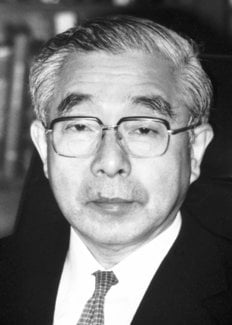Kenichi Fukui
Biographical

I was born the eldest of three sons of Ryokichi Fukui, a foreign trade merchant and factory manager, and Chie Fukui, in Nara, Japan, on October 4, 1918. In my high school years, chemistry was not my favourite subject, but the most decisive occurrence in my educational career came when my father asked the advice of Professor Gen-itsu Kita of Kyoto Imperial University concerning the course I should take. Prof. Kita suggested that Ryokichi, one of his juniors from the same native province, should send me to the Department of Industrial Chemistry with which he was then affiliated.
For a few years after my graduation from Kyoto Imperial University in 1941, I was engaged in experimental research on synthetic fuel chemistry in the Army Fuel Laboratory. The result brought me a prize in 1944. I became lecturer in the Fuel Chemistry Department of Kyoto Imperial University in 1943, assistant professor in 1945, and professor in 1951. In 1947 I married Tomoe Horie. I have two children, Tetsuya (son) and Miyako (daughter).
While I started originally as an experimentalist, I had built up a subgroup of theoreticians in my group before 1956. My work on experimental organic chemistry continued along with this, and the results were mostly published in Japanese papers, the number of which amounted to 137 during the period 1944 – 1972, together with my papers on reaction engineering and catalytic engineering.
But the nature of my main work in chemistry can be better represented by more than 280 English publications, of which roughly 200 concern the theory of chemical reactions and related subjects. Other English papers relate to statistical theory of gellation, organic synthesis by inorganic salts, and polymerization kinetics and catalysts.
My first scientific delight came in 1952 when I found a correlation between the frontier electron density and the chemical reactivity in aromatic hydrocarbons. This success led my theoretical group to the chemical reactivity theory, extending more and more widely the range of compound and reactions that were discussed.
The year in which my 1952 paper was published was the same as that of Professor Mulliken‘s publication of the important paper on the chargetransfer force in donor-acceptor complexes. Influenced by this paper, I gave a theoretical foundation for the findings mentioned above. The basic idea was essentially the consideration of the importance of the electron delocalization between the frontier orbitals of reactant species. The frontier orbital approach was further developed in various directions by my own group and many other scientists, both theoretical and experimental.
I was also interested in formulating the path of chemical reactions. The first paper appeared in 1970. This simple idea served to provide information on the geometrical shape of reacting molecules, and I was able to make the role of the frontier orbitals in chemical reactions more distinct through visualization, by drawing their diagrams.
I must confess that, when I was writing the 1952 paper, I never imagined I would be coming to Stockholm to receive the Nobel Prize 30 years later. But I have to add that already at that time Professor Gen-itsu Kita encouraged me by suggesting the possibility of the growth of my theory leading me one day to this supreme prize. The possibility became a reality through the good circumstances in which I found myself: with my teachers, my colleagues and students, and, of course, my parents and family.
| Some other details which perhaps should be mentioned are: |
| The Japan Academy Medal, May 1962. |
| National Science Foundation Senior Foreign Scientist Fellow, Feb.-July, 1970. |
| Member, International Academy of Quantum Molecular Science (France), from duly 1970 to the present. |
| Councillor, Kyoto University, Nov. 1970-March 1973. |
| Dean, Faculty of Engineering, Kyoto University, April 1971-March 1973. |
| US-Japan Eminent Scientist Exchange Program Chemist, Sept. 1973. |
| Counsellor, Institute for Molecular Science, from Jan. 1976 to the present. |
| Vice-President, Chemical Society of Japan, March 1978-Feb. 1979. |
| Chairman, Executive Committee, 3rd International Congress of Quantum Chemistry, Kyoto, Oct.-Nov. 1979. |
| Foreign Associate, National Academy of Sciences, April 1981. |
| Order of Culture, Nov. 1981. |
| Person of Cultural Merits, Nov. 1981. |
| Member, European Academy of Arts, Sciences and Humanities, Dec. 1981. |
| Professor Emeritus, Kyoto University, April 1982. |
| President, Kyoto Institute of Technology, June 1982-May 1988. |
| President, Chemical Society of Japan, March 1983-Feb. 1984. |
| Foreign Honorary Member, American Academy of Arts and Sciences, May 1983. |
| Member, the Japan Academy, Dec. 1983. |
| Member, Pontifical Academy of Sciences, Dec. 1985. |
| Professor Emeritus, Kyoto Institute of Technology, June 1988. |
| Director, Institute for Fundamental Chemistry, June 1988 to the present. |
| Imperial Honour of the Grand Cordon of the Order of the Rising Sun, Nov. 1988. |
| Honorary Member, the Royal Institution of Great Britain, March 1989. |
| Foreign Member, the Royal Society, June 1989. |
This autobiography/biography was written at the time of the award and later published in the book series Les Prix Nobel/ Nobel Lectures/The Nobel Prizes. The information is sometimes updated with an addendum submitted by the Laureate.
Kenichi Fukui died on January 9, 1998.
Nobel Prizes and laureates
Six prizes were awarded for achievements that have conferred the greatest benefit to humankind. The 12 laureates' work and discoveries range from proteins' structures and machine learning to fighting for a world free of nuclear weapons.
See them all presented here.
